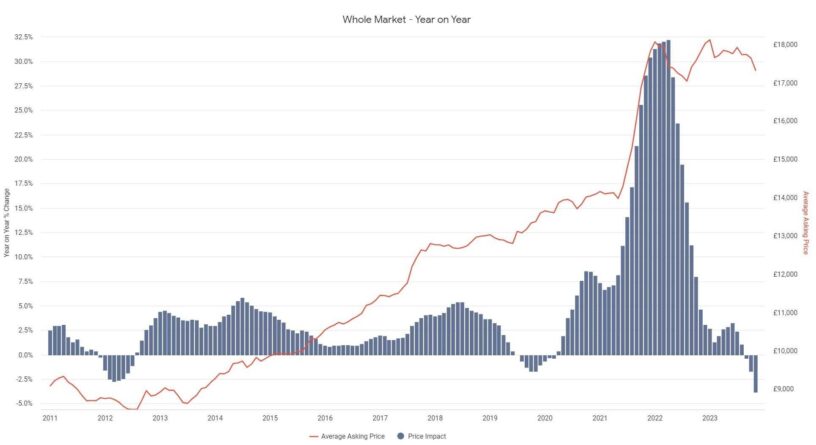According to the latest data from the Auto Trader Retail Price Index, average used car retail prices contracted on a year-on-year (YoY) basis in November, falling -3.8% like-for-like. Auto Trader’s data shows, however, that consumer demand and the speed in which cars are selling remain robust, as do retail prices in many segments of the used car market.
November marks the third consecutive month of YoY decline for retail prices, but as always in today’s fast-moving retail market, its essential to look beneath the headline figure for an accurate picture to base pricing strategies. A granular view of the data reveals considerable nuance, with a fall in retail prices among younger aged cohorts pulling the overall figure down. Indeed, those cars aged below five-years-old recorded a -6% drop in November, due to a combination of increased supply over recent months, as well as increasing pressure from new-car deals, particularly among electric vehicles (EV).
In contrast, those cars aged above five-years-old were up 1.3% YoY last month, whilst those aged over ten years-old increased 6.8%. This variable market strength is reflected in the different sales performance of franchise and independent retailers, with Auto Trader’s sale proxy data indicating a -0.6% and 5.1% YoY respectively.
This nuanced picture is reflected across different segments of the market. The average price of low emission vehicles was down -11.9% against November 2022; EVs in isolation, fell -21.1%. Their traditionally fuelled counterparts however, softened just -1.8% YoY. It’s a similar picture at a brand level; whilst premium and super premium cars dropped -6.5% and -3.6% respectively, the average retail price of volume brands contracted just -2.1%. At an even more granular level, prices of petrol and diesel volume brand cars increased last month, rising 0.6% YoY and 0.4% respectively.
Strong Market Health growth as demand outpaces supply
Crucially, Auto Trader’s data reveals that demand, as determined by consumer engagement on its platforms, has increased on last year across all market segments, including ‘nearly new’ cars (those aged less than 12 months old), which have seen demand growth (39% YoY) outpace supply (29% YoY) for the first time in over a year[1]. At a total market level, demand growth is up 9% on November 2022, marking an increase on the 6.8% recorded in October, as well as the third highest rate recorded this year.
With current levels of consumer appetite ahead of the volume of stock entering the used car market (up 2.8% YoY), Auto Trader’s Market Health metric, which assesses market profitability based on supply and demand dynamics, rose from 4.3% YoY in October, to 6.1% last month. It’s a considerable increase on the -11.3% decline recorded in November last year, when the market was affected by the economic uncertainty and disruption caused by the then Prime Minister, Liz Truss’ ‘Mini-Budget’, which fuelled a rapid growth in inflation and interest rates.
Today, the market faces less uncertainty, and as a result, Market Health across all but two segments[2] have improved on last year’s levels, and consequently, so too has the speed in which used cars are selling, which at a total market level was just 31 days. Unusually for this time of year (when the speed of sale typically slows between October and November), it was flat against the prior month. It’s also faster than pre-pandemic norms; it took an average of 33 and 35 days for cars to sell in November 2019 and 2018 respectively. Further highlighting the robustness of the used car market, Auto Trader saw 69.8 million visits to its marketplace last month, which is a 12% increase on November 2022.
Despite the positive growth in Market Health and the favourable supply and demand dynamics, Auto Trader’s data indicates there’s been a recent increase in re-pricing activity, with retailers making broad price reductions across their forecourts. 16%[3] of all cars being advertised on Auto Trader were priced below their market value in November, which is a significant increase on the already worryingly high 14% recorded in October and suggests retailers are leaving potential profit on the table.
Commenting, Auto Trader’s director of data and insights, Richard Walker, said: “As we’ve been reporting for some months now, retail prices remain robust across segments of the market, demand is increasing, and cars are selling quickly. I’d urge retailers therefore, not to give up potential opportunities based on trade data alone, which only show one side of the story. Car buyers aren’t aware of wholesale trends and are prepared to pay what they think is a fair price based on the retail market value, not what a retailer paid it for.
“With trade and retail prices no longer in sync, there’s an opportunity for retailers if they use a complete view of the market to guide their decisions. Every car has a retail price at which it will sell, so retailers should take a vehicle-by-vehicle approach and use the right metrics to spot the most profitable stock for their forecourts. More than ever, the opportunities are in the detail.”
*Article Source https://plc.autotrader.co.uk/








